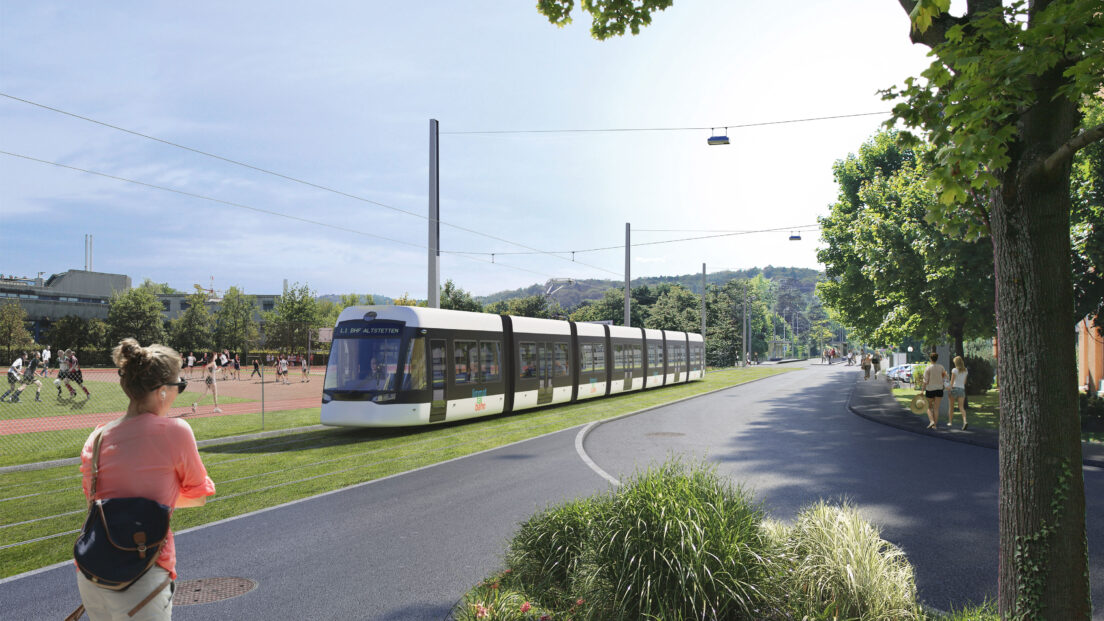"We are on course on all construction sites"

Daniel Issler, Managing Director of Limmattalbahn AG, is responsible for the construction of the second stage from Schlieren Geissweid to Killwangen-Spreitenbach. He explains why the Limmattalbahn is more advantageous than a bus route and what challenges the construction work entails.
The first stage of the Limmattalbahn between Zurich Farbhof and Schlieren Geissweid has been in operation for over a year. The tram is well accepted and used extensively. “There is hardly any distinction between 'old' and 'new' routes,” says Oliver Obergfell from the VBZ media office. The Grüntrassee also made a very good impression after one year of operation. On average, around 5000 people use the Schlierem stops during the week – this roughly corresponds to the number of passengers on the former bus route 31. The Limmattalbahn (LTB) AG is also satisfied with the operation. "So far we have hardly had any complaints with regard to the infrastructure," says managing director Daniel Issler.
The second stage of the Limmattalbahn between Altstetten station and Zurich Farbhof and between Schlieren Geissweid and Killwangen-Spreitenbach has been under construction for a year. Here, too, everything is going according to plan: “The construction work is making very good progress. We are on course or even a little faster on all construction sites, ”says Issler. There are currently no signs of a cost overrun. The overall project manager also sees himself confronted with challenges: "In the second stage, construction work will take place over a length of around 10 kilometers at the same time." Then there are the large structures such as the Färberhüsli tunnel in Schlieren, the underpass at the Dreispitzkreuzung in Dietikon and the ramp structure in Killwangen.
A bus line could not cope with the increasing number of passengers
The construction of the Limmattalbahn is associated with restrictions and immissions for residents, entrepreneurs and road users along the route. LTB AG is aware that the construction site of the Limmattalbahn will cause some inconvenience. “We are therefore trying to build as quickly as possible in order to reduce the restrictions to a minimum. If someone contacts us with a concern, we endeavor to find individual solutions, ”says the managing director. Issler once again emphasizes the benefits of the continuous Limmattalbahn from Zurich Altstetten to Killwangen-Spreitenbach: "Public transport is being strengthened – the Limmattalbahn is a supplement to the existing S-Bahn and enables a continuous and reliable travel chain." The much-brought-up argument of the Limmattalbahn opponents – that an expansion of the existing bus networks in the region would have been enough and would have come more cheaply – is invalidated by the head of LTB AG: “The Limmattal is developing rapidly. Many innovations are still to come. A bus route could not cope with this growth. In addition, a bus always runs the risk of getting stuck in a traffic jam. "
The announcement of the Limmattalbahn has already triggered numerous construction activities along the route. Old buildings are being renewed, new commercial and residential buildings are being built. Issler expects this trend to continue and even intensify. The growth also exacerbates the already existing traffic problem in the Limmat Valley. Can the Limmattalbahn provide a remedy here? “One of the goals of the Limmattalbahn is to absorb most of the additional traffic caused by public transport. Since measures for individual motorized traffic are also being implemented at the same time, we are confident that road traffic will also become liquid as a result, ”says Issler.
The second stage should be completed in mid-2022. This is followed by test drives. Official operations are scheduled to begin when the timetable changes in December 2022. Then the Limmattalbahn covers a distance of 13.4 kilometers at an average speed of 22 km / h: from Zurich Altstetten via Schlieren, Urdorf, Dietikon, Spreitenbach to Killwangen. The tram stops 27 times and has a capacity for 260 passengers. The cantons of Zurich and Aargau, as well as the federal government, spent a total of 755 million francs on the first two stages.
The Aargau government is currently working on plans for a third stage: from Killwangen-Spreitenbach to Baden. In late summer 2020, the Grand Council decided to keep the route clear and to raise the continuation of the tram route in the cantonal structure plan from the previous status of “preliminary orientation” to the level of “interim results”. The extension of the Limmattalbahn thus has a good chance – but a few hurdles still have to be overcome before a final decision can be reached. The start of operations for the last stage, if it is actually implemented, is not expected before 2032. ■